There are cost-effective solutions for 15-m cable lengths
BY PHILIP GADD
Quellan, Santa Clara, CA
http://www.quellan.com
If an engineer wanted to get large amounts of data from point A to point B, he or she has traditionally been limited to one or two forms of cable interconnection based on the protocol and type of equipment to be connected. If they were looking at SAS storage options they were constrained to a passive copper connection, as the standard did not make provision for power to allow the use of optics or other interconnect technology. For other standards like 10GbE, FCoE, or Infiniband using SFP+ or QSFP connectors found in NICs and switches, the option was passive copper or fiber optics.
The last 12 months have seen the deployment of equipment at ever-faster data rates as 10 GbE and QDR Infinband have become mainstream technologies in a large data center and other high-speed applications.
The increased bandwidth has put further strain on the reach of lower-cost passive systems and has forced users to make the jump to fiber optics, which for most reach requirements in the data center is overkill and has higher power consumption and operating cost. There has been an attempt to extend the reach of passive copper by using additional signal conditioning on each port (various EDC or 10GBase-KR-type ICs), but these technologies use expensive 0.65-µm (or smaller) CMOS technology and typically draw watts of power, so the overall connection cost was not significantly reduced.
Active twin-ax copper cables
An option that has emerged is active twin-axial copper cables using lower-cost 0.13-µm CMOS ICs to condition signals inside the cable connector. By conditioning the signal before it makes the jump across the connector, crosstalk interference is minimized. Depending on the features of the IC embedded in the active cable, it is possible to use thinner gauge cable, lowering cost and improving cable management.
Active cables can extend the use of copper cables from 3 to 5 m to just over 15 m at 10-Gbit/s data rates and to over 25 m at 6 Gbits/s (see Fig. 1 ). This enables storage array and server cluster footprints to be increased and, combined with the newest generation of modular switching systems like the Cisco Nexus 7000, allows up to 8,000 server nodes to be configured with one unified fabric switch in a double-layer system.
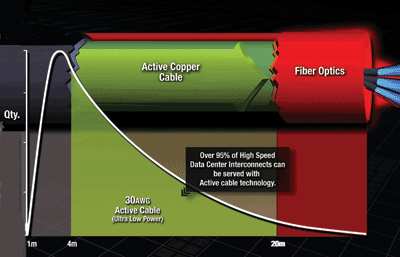
Fig. 1. Active copper cables can meet 95% of the data center’s cabling needs.
The white line of Fig. 1 shows the distribution of connection lengths in a large data center and 95% of the cables are less than 25 m. This makes the 100 to 300-m capability of fiber optics overkill and the price paid in terms of power consumption and cost is not one that the industry can afford.
Cost savings
As the economy struggles to recover from the recession, data center Capex and Opex numbers are receiving increased CFO focus across the globe. With street prices for fiber optics costing hundreds of dollars per transceiver and with each connection requiring two transceivers and a multistrand fiber-optic cable, it is not uncommon for a data center user to pay $500 for a single link. Active Copper Cable pricing is in the $100 to $200 range depending on protocol. The Capex savings for a new storage cluster can reach millions of dollars in a large installation.
The savings also occur because the power consumption of active copper cable can be 50% to 200% lower than fiber optics, and especially 10GBase-T technologies. The carbon footprint of data centers is already half that of all of the world’s airlines and as large as several countries (see Fig 2 ). In a 50-MW high-speed infrastructure of typically 50,000 servers, the cost savings, even if the infrastructure has a state-of-the-art PUE of 1.5, can translate into many thousands of dollars.
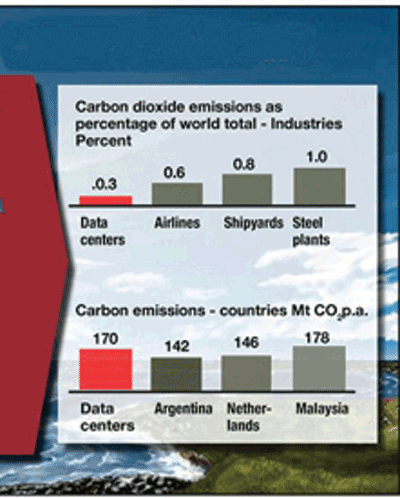
Fig. 2. Carbon footprint of data centers vs other entities.
Other benefits of copper
Active copper cables have many other benefits compared to traditional passive copper technology, fiber-optic transceivers, or the emerging 10GBase-T technology. By compensating for attenuation and group delay dispersion in the cable, active copper connections can use a much smaller gauge for cable, resulting in cost savings and ease of cable use. At 5 m, a 10-Gbit/s passive cable would need to be 24 AWG versus 32 AWG for an active cable.
The reduction in diameter and weight cuts the costs of cable management, and cooling also improves as the smaller bundles do not restrict airflow as much. Figure 3 shows an example of a passive CX4 Xaui cable that carries 10-Gbit/s data versus an Active QDR QSFP cable capable of carrying 40 Gbits/s.
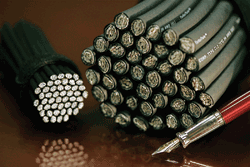
Fig. 3. Comparison of 10-Gbit/s QSFP Active Cable (left) versus 10-Gbit/s CX4 passive cable.
Another challenge for the high-speed cable user when faced with an empty cage slot on the equipment is to know the actual specification of the port. As industry specifications have evolved, we find ourselves with ports supporting different versions of the popular specifications.
The best example is found on an SFP+ 10-GbE port where the data center engineer has no way of telling by looking at the box what version of the SFF spec the port supports. The OEM may have added some proprietary silicon (which increases port cost and power consumption) to drive passive copper farther (as long as the same silicon is installed at the other end). The same port could also easily be an SFF 8431 linear port or a limiting port and in the future could also be an SFF 8461 port.
Each port type has different specifications for passive copper reach, with the worst case being as short as 1 m. No need to worry using an active copper cable, as all port types will reach at least 15 m.
Tables 1 and 2 summarize this benefit. With large infrastructures having 10,000 servers and potentially 100,000 interconnects, the plug-and-play feature of active copper is important.
Table 1. Passive Cables
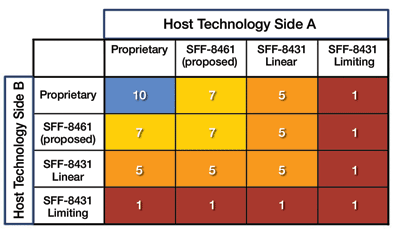
Table 2. Active Cables
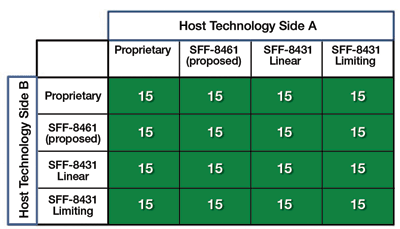
Part of the hidden cost of large high-speed deployments is the time and effort required to configure new installs and the affect on the business users. As active copper cables require no special treatment at the box level and are agnostic to the actual specification of the port, an engineer can plug and play with no additional thought or time spent on optimizing the configuration.
The SFP+ 32AWG, 5 Meter 11G active copper cable from Quellan is one example of the many readily available active cables on the market. This very-small-diameter cable/connector assembly supports data rates up to 11.1 Gbits/s and costs only $200 in single quantity. QSFP and mSAS assemblies are also available. ■
Advertisement
Learn more about Quellan





